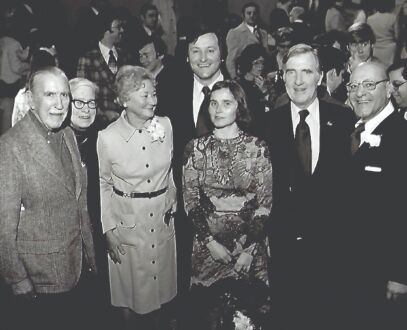"Life in American Politics & Diplomatic Years in India" | An unvarnished account
Life in American Politics & Diplomatic Years in India is the memoir of Richard Celeste — an American diplomat, university administrator and politician from Ohio; Excerpts:
Author: Richard Celeste
Publisher: Har-Anand Publications
At five am on Wednesday, March 6th, 1985 my phone rang. I picked up immediately. “Governor,” Marvin Warner told me, “we have a problem.” This was Ohio’s precursor of the financial meltdown that would eventually be known around the world as the Savings and Loans Crisis.
Marvin Warner didn’t’ have to introduce himself. I had put him in charge of the Ohio Building Authority, in part to oversee the construction of the Riffe Office Tower where Jim Rhodes had tried to break ground during my inauguration. Warner tossed out the Rhodes plan and oversaw a design both more attractive and more efficient than the sixty-six story monstrosity the previous administration had proposed. Marvin was tough and smart. He was also one of the few people to have my personal number and it was clear he was worried. “There’s been a failure of a financial institution in Florida,” he told me. “And it’s going to affect our liquidity at Home State.”

Wide awake now, I told him to go on.
In a few hours, he told me, the Cincinnati Enquirer would publish a story revealing his Savings and Loans—Home State—had deposited a substantial sum of money with a securities firm in Florida named E.S.M. which had declared bankruptcy.
“We need help,” he told me.
Warner was not the sort of person to confide in you for no reason. His doing so indicated the severity of the situation. Anything less, he would have gone to Vern Riffe or Stanley Aronoff, both of whom were considerably closer to him than me. In fact, I suspect he had reached out to Vern who told him to contact me. I know he tried to enlist the help of Stan Aronoff who was vacationing in Israel when he got the call. In any event, Warner was now calling me.
I cut him off before he could get too far into his appeal. “Look,” I said. “I’m going to have Ray Sawyer get back to you. And we can go from there.”
Then I hung up and tried to go back to sleep.
I knew Marvin Warner. He was one of my major supporters and I trusted him enough to appoint him to a key position. While some folks assume he had me in his pocket, it was never the case. Despite our association I was always careful to keep him at an arm’s length. My first contact with him had come through Jack Gilligan. After I won the nomination for Lieutenant Governor, the Governor had given me a list of potential financial contributors. Warner’s name had been on that list. I went to see him, ironically, at Home State where I hemmed and hawed before finally asking him for a contribution. He had expected the ask, of course, and responded by handing me an envelope.
I thanked him but once outside I opened the envelope to discover ten one hundred dollar bills. A thousand dollars cash.
I could not take it. After all, I had sponsored the bill that limited cash contributions to one hundred dollars. I got out of my car and went back into the building.
It was a generous contribution, I told Warner, “but I can’t accept it.” Marvin was nonplussed and asked the reason. I explained my legislation that had put the cash limit in place. He took back envelope and wrote me a check instead, folded it in half and handed it to me. I thanked him again.
Once in my car I unfolded the check. It was for five hundred dollars. From that moment on Marvin Warner and I understood each other. I respected him as a successful business and community leader who had been a very strong supporter of Jimmy Carter and who was providing strong leadership at the Ohio Building Authority.
It was clear when Marvin called that he had a problem. What was not clear is why he had called the Governor. Being Governor there are literally thousands of people who want their problem to become your problem. Ohio was then a multi-billion dollar operation with thousands of employees and hundreds of departments and divisions and with citizens constantly pressing for attention. A Governor has to make quick decisions about what’s important and what can look after itself. What would turn out to be a grave crisis initially seemed to me to be something that could look after itself. It was a banking problem, one that the banks should and would resolve on their own. What did Marvin know that I didn’t?
That morning there would be no going back to sleep. As it would turn out, few of us would get much sleep for the next few months. The first person I called was Jan Allen who had heard nothing about the situation. If Marvin Warner was that concerned, we needed to get up to speed on it. Next I called my Chief of Staff Ray Sawyer and filled him in. He would get in touch with Warner, get the details and report back to me.
A couple of hours later we had at least some idea of what was going on. A securities firm in Fort Lauderdale called E.S.M. Government Securities had gone under. While fraud had been alleged there was little concrete information. It was also difficult to tell whom it would impact—other than Home Savings. What we knew was that E.S.M. Securities owed Home State millions of dollars and would not be able to pay. The savings of Ohio depositors had evaporated. By the time Ray Sawyer got back to me later that morning, he had also heard from Ken Cox, the newly appointed Director of the Ohio Department of Commerce. Cox had found out about the Cincinnati situation independently when calls started to come into his office. Sawyer agreed with Cox that Home State was exposed; the two seemed to think that might possibly be the extent of the problem. There had been an initial run on the bank, but it had not been devastating.
The instinct of bankers is always to let a run continue, “to put cash in the window” and in that way reassure depositors. What people care about in a circumstance like this is getting their money back. For the moment Home State seemed able to do that. The question was: if the run continued how long would Home State be able to meet its obligations?
To answer that question Cox and Sawyer called a meeting with Thomas Batties, interim head of the Division of Savings and Loans within the Ohio Department of Commerce, and Ken Elshoff, head of the Ohio Savings and Loans League. They concluded the situation was serious but not desperate. Home State funds were covered by a private insurance association called the Ohio Deposit Guarantee Fund and they were ready to step in. Much depended on the Ohio Deposit Guarantee Fund—ODGF, for short—having the liquidity needed to cover the Home State shortfall.
We realized quickly that a problem ODGF posed was its name—which implied that the State of Ohio stood behind it, perhaps even that the State was guaranteeing their deposits. It was, after all, the Ohio Deposit Guarantee Fund. In truth, however, the OGGF was a private insurance arrangement. The S and Ls insured by ODGF were state-chartered institutions which had decided not to be part of the Federal Savings and Loan Insurance Corporation (FSLIC)— based in Washington and charging a considerably higher premium. A typical customer entering an S&L could see for him or herself that the safety of their money was guaranteed by the Ohio Deposit Guarantee Fund, its seal was right there on the front door. The general impression that the State insured these S&Ls led Ray Sawyer and others on my staff decide to issue a statement expressing confidence in the system. Panic was to be avoided at all costs because a run on the banks might prove catastrophic. Cox issued a statement that afternoon saying that the system was sound. So did Karen Horn, the newly appointed President of the Cleveland Federal Reserve.
That evening I went to a basketball game. Michigan crushed Ohio State. It was not a great day. The basketball defeat would prove to be the least of it.
Thursday—the next day—began with Ray Sawyer who told me that the Federal Reserve had sent examiners to Cincinnati to inspect the Home State books in order to get a handle on the extent of their exposure. One quick option would be to find a buyer for Home State. The million dollar question—or in this case the two hundred and fifty million dollar question—had to do with understanding how much the bank owed above and beyond its remaining assets, and, further, how covering those losses would affect the liquidity of ODGF itself.
Excerpted with permission from Bike Ambulance Dada; published by Penguin Random House



